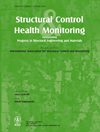Soft capacitive sensor for structural health monitoring of large-scale systems
SUMMARY
Structural integrity of infrastructures can be preserved if damage is diagnosed, localized, and repaired in time. During the past decade, there has been a considerable effort to automate the process of structural health monitoring, which is complicated by the inherent large size of civil structures. Hence, a need has arisen to develop new approaches that enable more effective health monitoring.
In this paper, a new sensing technique for damage localization on large civil structures is proposed. Specifically, changes in strain are detected using a capacitance sensor built with a soft, stretchable dielectric polymer with attached stretchable metal film electrodes. A change in strain causes a measurable change in the capacitance of the sensor, which can be directly monitored when the sensor is fixed to a structure.
The proposed method is shown here to permit an accurate detection of cracks. The proposed system deploys a layer of dielectric polymer on the surface of a structural element, and regularly monitors any change in capacitance, giving in turn information about the structural state. The smart material is composed of inexpensive silicone elastomers, which make the monitoring system a promising application for large surfaces. Results from tests conducted on small-scale specimens showed that the technology is capable of detecting cracks, and tests conducted on large-size specimens demonstrated that several sensor patches organized on a sensor sheet are capable of localizing a crack. The sensor strain also exhibits a high correlation with the loss of stiffness. Copyright © 2010 John Wiley & Sons, Ltd.




